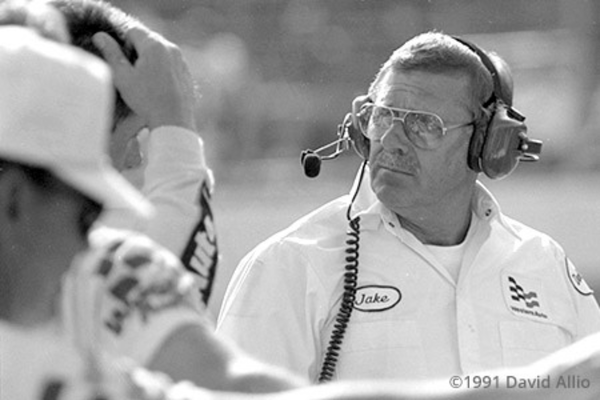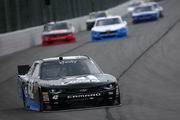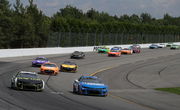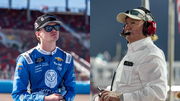

The iconic NASCAR crew chief Jake Elder, affectionately known as “Suitcase Jake,” was well-known for his nomadic career and mechanical prowess. Elder reached the height of NASCAR glory thanks to his innate grasp of race cars, even though he only had a third-grade education.
Among his notable accomplishments throughout his tenure were helping David Pearson win back-to-back titles in 1968 and 1969 and being instrumental in Darrell Waltrip and Dale Earnhardt’s early careers, helping them both win their first NASCAR Cup. Elder is a strong contender for one of NASCAR’s greatest awards, and this nomination is evidence of the lasting influence he has on the sport.
ADVERTISEMENT
Article continues below this ad
Who was Jake Elder?
Elder’s career straddled two distinct eras in NASCAR—the grassroots, gut-feel mechanical days of the 1960s and 1970s and the data-driven, corporate NASCAR of the 1980s onward. He symbolized the last wave of hands-on crew chiefs who relied purely on instinct before computers and engineering degrees took over pit boxes. Despite being bright and outspoken, Jake Elder was as unpredictable as the races he helped win. Above all, he was a mechanical genius, a legend of NASCAR’s golden age. Born in 1936 in rural North Carolina, Elder left school after third grade, learning by doing, listening, and watching. He didn’t chase racing – his raw talent made it impossible for racing to ignore him.
He didn’t use simulation tools or wear a headset when analyzing data. Instead, he employed a sense of pressure, weight, and metal that textbooks couldn’t impart. Jake Elder used magic instead of arithmetic to make race vehicles faster. He was known for being both brilliant and volatile. Because Elder rarely stayed with one team for an extended time, he was known as “Suitcase Jake.” He traveled frequently, packed light, and didn’t hesitate to leave if something didn’t feel right. However, he demonstrated his ability to transform mediocre setups into race-winning vehicles while he was a member of teams like Holman-Moody, Wood Brothers Racing, and Rod Osterlund Racing.
Elder launched the careers of future Hall of Famers Dale Earnhardt and Darrell Waltrip after leading David Pearson to consecutive titles in 1968 and 1969. His blunt, occasionally harsh, but always honest, communication approach influenced the mindset of tough-minded racers.
Elder left a lasting legacy despite never pursuing fame. He served as a link between the days of hammers and gut feeling and the emergence of precise engineering. Jake Elder served as a reminder that in a sport that relies heavily on statistics these days, the person who never needed a calculator might sometimes be the brightest man in the garage.
Trending
From welder to atop the pit box, Jack Elder’s rise in NASCAR
Jake Elder did not use the front door to enter NASCAR. He entered through the garage, savage, unrelenting, and too natural to resist. Elder was born in North Carolina in 1936, dropped out of school after the third grade, and started working as a welder. But he saw rhythm where others saw machines. By touching sheet metal, adjusting suspensions by feel, and learning by doing, he studied aerodynamics without attending a classroom.
Whilst Elder was well-known on local short tracks by the late 1950s, it was his joining Holman-Moody, the formidable Ford operation, that gave him his big break. He gained experience there working with some of the top mechanics in the industry. As crew chief for David Pearson at Wood Brothers Racing in 1968 and 1969, Elder’s skills gained widespread recognition. They won consecutive NASCAR Grand National Series titles together. Elder’s lack of formal education—everything he knew he learned the hard way—made the accomplishment all the more impressive.
What’s your perspective on:
Could NASCAR's modern era use more 'Suitcase Jake' style intuition over data-driven strategies?
Have an interesting take?
Elder’s presence was more distinctive than his technical prowess. In the early ’70s at North Wilkesboro, “Suitcase Jake” had had enough. Frustrated by teams secretly soaking tires for extra grip, he made his protest loud and clear by dumping a full gallon of rubber softener on his team’s tires in front of everyone. No sneaking around, no whispers—just a bold, in-your-face move that called out what others wouldn’t. It was classic “Suitcase Jake”: fearless, principled, and unafraid to shake the system.
Elder famously assisted Darrell Waltrip in winning his first Cup Series in the middle of the 1970s. He was instrumental in the beginning of Dale Earnhardt’s illustrious career, a few years later, helping him win his first Cup in 1979. Elder yelled, “Shut up and drive,” in response to Earnhardt’s question about his car’s configuration. It became legendary in NASCAR. Elder’s statistics speak for themselves despite his brief career. As a crew chief, he worked with a long list of racing luminaries and recorded 44 victories. More than awards, though, his legacy is found in the way he demonstrated that, occasionally, gut instinct can triumph over refined lineage by bringing grit and intuition to the pit box.
Jake Elder’s role in mentoring and shaping the legacy of Richard Petty and Dale Earnhardt
In a sport dominated by legends, Jake Elder made history without ever needing a trophy or a title. Rather, he left behind men who were tougher and faster. Dale Earnhardt and Richard Petty stood out among them all. Although Elder didn’t have as much direct contact with Richard Petty as some others, he was present when NASCAR was growing and the King was in power. Elder worked on opposing teams, frequently shared garages, and contributed to the creation of the precise setups that Petty had to defeat. It wasn’t easy to earn their regard.
Petty remarked that Elder was “old school” and favored practical changes over engineering calculations when he worked at Petty Enterprises in the 1960s. He recalled Elder saying, “OK, now it’s right. Here, you go drive it. And don’t come back in complaining to me, because I got the car fixed. You go learn how to drive it”. Petty’s crew had to step up their game to compete with the cars Elder was helping produce because he wasn’t just tuning engines; he was tuning entire eras of competition. From the other side of the aisle, “Suitcase Jake” shoved the King of NASCAR despite not donning Petty’s colors.
Dale Earnhardt, however, would eventually come to represent Jake Elder’s tough, pragmatic influence. Elder was Earnhardt’s crew chief with Rod Osterlund Racing in 1979, when he was still raw and unpolished. The two shared traits: they were blunt, working-class, and instinct-driven. The emergence of “The Intimidator” began when Elder led Earnhardt to his maiden NASCAR Cup Series victory at Bristol. They had an electrifying dynamic. Earnhardt fulfilled Elder’s expectations with performance. One of the most famous quotes in NASCAR history, “Shut up and drive,” was Elder’s response to Earnhardt’s questioning of the car’s handling. It was a philosophy rather than merely an order. Elder was aware that Earnhardt needed a fire kindled beneath him, not assurance. Earnhardt won his first Rookie of the Year award in 1979 and went on to win seven more thanks to his fire.
Elder’s fingerprints were found on his identity as well as on Earnhardt’s vehicle. A mentor who never accepted excuses and didn’t believe in second-guessing accentuated the toughness, arrogance, and refusal to back down. Jake Elder left before claiming credit. Seldom did he remain long enough to enjoy the glow of achievement. But whether he was on the pit box or across the garage, he contributed to the creation of two of NASCAR’s greatest legacies by believing in something more profound than the rules: gut, grit, and a sense of greatness.
ADVERTISEMENT
Article continues below this ad
Jake Elder’s demise and the nomination for NASCAR’s Hall of Fame
Jake Elder’s latter years were quiet, unappreciated, and away from the attention he never requested, which was a lot like his NASCAR career. Elder faded into retirement in the early 2000s after decades of tinkering with stock cars, molding champions, and storming out of more garages than most people ever enter. After a protracted illness, he died in 2010 at the age of 73, leaving behind a legacy that had long been discussed in pit lanes but had never been completely honored on the biggest platform in the sport.
Elder rarely carried out interviews, never sought publicity, and never pushed for awards, even though he helped define NASCAR’s heyday. He imparted lessons about trust, toughness, and how to feel speed with your bare hands through stories that were told in hauler bays and late-night shop sessions. For many years, it appeared that his legacy would live on in recollections rather than monuments.
ADVERTISEMENT
Article continues below this ad
However, NASCAR takes action to alter that in 2025. Under the Pioneer Ballot, which is only given to people whose careers started more than 60 years ago and who established the sport, Jake Elder was nominated for the 2026 NASCAR Hall of Fame. While garage insiders revered him, many casual fans never fully knew who he was. His candidacy is a recognition of all he contributed to the sport that didn’t fit in a record book, not just a credit to victories and titles. It’s because of the unvarnished mentoring he provided to greats like Dale Earnhardt. He created the configurations without the use of simulators. For the unyielding genius who could sense a loose vehicle without listening to the driver’s voice.
Though Jake Elder didn’t stay long, his influence endured. And now, almost ten years after his death, “Suitcase Jake” might finally get a permanent spot in the sport he helped create—something he never asked for but always deserved—thanks to the Hall of Fame.
ADVERTISEMENT
ADVERTISEMENT
ADVERTISEMENT
ADVERTISEMENT







Could NASCAR's modern era use more 'Suitcase Jake' style intuition over data-driven strategies?